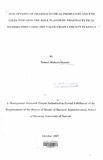| dc.contributor.author | Ikundo, Nobert M | |
| dc.date.accessioned | 2013-05-10T09:07:37Z | |
| dc.date.available | 2013-05-10T09:07:37Z | |
| dc.date.issued | 2007 | |
| dc.identifier.citation | Master of Business Administration, | en |
| dc.identifier.uri | http://erepository.uonbi.ac.ke:8080/xmlui/handle/123456789/21179 | |
| dc.description.abstract | As organizations streamline their production and internal processes, the next opportunity for
improvement is through better coordination and networking with their suppliers and
customers through the supply chain. Much of the cost and value creation occur in the supply
and distribution chain. The purpose of value chain is to attain full and seamless interaction
among stakeholders to create a win- win situation for all. Identification and analysis of cost of
activities and the roles played in business processes from production to sales has great
potential in unlocking value.
This study focuses on the supply and distribution of pharmaceutical products in Kenya. The
research work was to investigate the pharmaceutical producers' and end users' perception
towards the role and value contributed by distributors in the provision of medical supplies in
Kenya using the Value Chain Concept.
•
Players in the medical supply chain in Kenya are spread all over the country. The population .•..
consisted of two groups; the producers and end users each relatively homogeneous. A
representative sample from each stratum of the population was used. To ensure adequate
representation, stratified probability sampling method was used in selecting the sampling
units from each of the sampling frame. The sample size took account of the dispersion of t"e
population, the desired level of accuracy and interval range. A structured questionnaire was
used to collect primary data. Secondary data was obtained from the company's management
information system and printed records. Analysis of the data was done by the LIseof SPSS
software and Microsoft Excel spreadsheet.
VIII
One of the key findings from the study was that 76% of the producers channeled up to one
half of their business through the distributors while 24% relied on distributors to sell more
than half of the products manufactured or imported. It also emerged that half of the users
sourced more than one half of their stocks from distributors. This finding indicates heavy
reliance on the distributor to put through products in the supply chain.
The study also found out that both producers and users were most satisfied, mean 3.80 and
3.45 respectively on a scale of 1-5, with the distributors' ability to promptly deliver products
upon order placements. The producers were least satisfied (mean 2.17) with the amount of
discounts and commissions demanded by the distributors.
It was also found out that users were least satisfied (mean 2.93) with distributors' lack of
value adding services such as product information/support and marketing. Further, ownership
of products remained with the producers until they were sold. Thus any losses resulting from
expired or unsold products were fully incurred by producers.
The study recommended that their operations especially with producers be guided by
professionally done contracts to rule out exploitation and intimidation. It was also
recommended that the government gives more incentives to local manufacturers as boost to
local production of pharmaceutical products. | en |
| dc.description.sponsorship | University of Nairobi | en |
| dc.language.iso | en | en |
| dc.title | Perceptions of pharmaceutical producers and end users towards the role played by pharmaceutical distributors using the value chain concept in Kenya | en |
| dc.type | Thesis | en |
| local.publisher | School of business,University of Nairobi | en |

